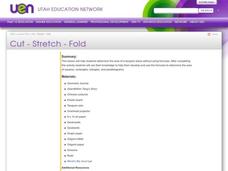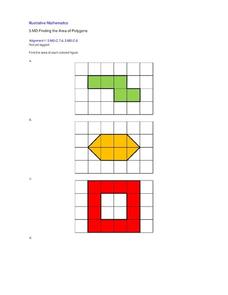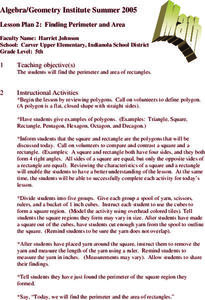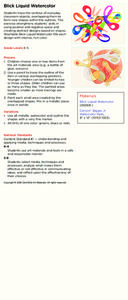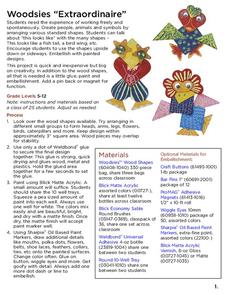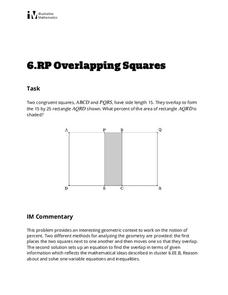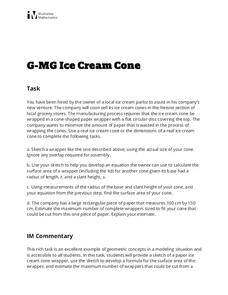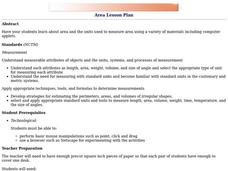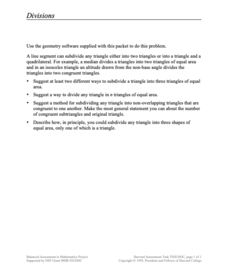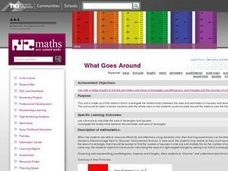Common Core Sheets
Determining Rectilinear Area
Third graders find the area of rectilinear shapes by partitioning them into two non-overlapping rectangles and adding the areas of the non-overlapping parts together. It allows learners to recognize area as an additive.
Curated OER
Area of Tangram Pieces
Mathematicians calculate the area of a tangram piece without using formulas. They use a geometry journal to record activities during this instructional activity. They make a set of tangrams and use them to...
Curated OER
Finding the Area of Polygons
Third graders are exposed to finding the area of polygons by decomposing figures and recomposing them into rectangles. This strategy allows children to expand on their prior knowledge of constructing shapes by rearranging parts into...
EngageNY
Properties of Area
What properties does area possess? Solidify the area properties that pupils learned in previous years. Groups investigate the five properties using four problems, which then provide the basis for a class discussion.
Curated OER
Finding Perimeter and Area
Geometers find the perimeter and area of rectangles. They discuss the definitions and characteristics of rectangles and squares. In groups, they use yarn to discover the perimeter of squares and rectangles. They count cubes to explore...
Shodor Education Foundation
Overlapping Gaussians
Adjust the overlap to compare probabilities. Using sliders, learners adjust the shape of two Gaussian curves. The interactive calculates the area of the left tail for one curve and the right tail for the other. Pupils set the interactive...
Alabama Learning Exchange
Abundant Area
Explore the relationship between perimeter and area. Learners input the area and perimeter for shapes on the Shape Explorer website, solve problems using geoboards, complete a worksheet, create a PowerPoint presentation, and take an...
Curated OER
Blick Liquid Watercolor
Introduce this abstract art to your class; they must chose ordinary classroom objects and shapes to paint with watercolors. The overlapping effect will create a fun, abstract piece of art!
Curated OER
Woodsies "Extraordinaire"
Allow your class to use their imaginations and create fun creatures with various wooden shapes and other embellishments. What a great way to encourage your young artists to stretch their minds!
Illustrative Mathematics
Overlapping Squares
The objective of this activity is to find the percent of the area of a two squares overlapping. Mathematicians find the ratio of area for the part that overlaps to the rectangle formed. The final answer is a percent as a rate per 100....
Curated OER
Geography: Lengths, Perimeter, and Area of Similar Objects
Sixth graders explore characteristics of similar objects. Using attribute blocks, they explore the ratios of the perimeter, area and side length in similar shapes. They calculate and compare the area of shapes.
Illustrative Mathematics
Ice Cream Cone
Every pupil with a sweet tooth will be clamoring for this lab and analysis, particularly when they're allowed to eat the results! Volume and surface area formulas for cones are developed from models, and then extended to the printing of...
Curated OER
Lengths, Areas and Shapes - Week 9
In this lengths, areas and shapes worksheet, students explore overlapping and non-overlapping patterns. They identify the number of objects in a pattern, determine how the pattern may be folded to create additional patterns, and...
Curated OER
The Surface Area of a Cylinder
Students measure the circumference of a cylinder. In this cylinder lesson plan, students use round container lids and flexible rectangles to measure the circumference of the cylinder. They put the shapes together to make their own...
Curated OER
Forests and Treescapes with Romey Stuckart
Students discuss Romey Stuckart's painting, "The Cedar," paint a tempera or acrylic picture of a forest or treescape, using overlapping shapes, intense hues, and heavy brush textures, and discuss managed forest techniques preserve...
Curated OER
Area Lesson Plan
Learners explore geometry by using computer applications. In this spatial measurement lesson, students discuss the difference between area, weight, volume and other forms of measurement. Learners utilize computer applications to find the...
Pennsylvania Department of Education
A Geometric Scavenger Hunt
Fifth graders connect their knowledge of polygons and polyhedrons. In this geometric shapes lesson, 5th graders identify and classify two- and three-dimensional objects. Students construct a polyhedron out of polygons and describe their...
Curated OER
Introducing Powers and Models
Students construct two dimensional models to illustrate squared numbers. In this geometry lesson, students use graph paper and an x/y axis to build squares exponentially. Students identify powers and relationships between various figures...
Curated OER
Measurement Crafts- Cereal Hands and Feet
Students identify nonstandard units of measurement and investigate area of objects. For this geometry lesson, students trace their hands and glue cereal pieces to the print to find the area.
Dick Blick Art Materials
Woodsies “Extraordinaire”
"This looks like an owl!" Kids get a chance to create all sorts of things by arranging various shapes, painting them, and gluing them together. A great way to encourage creativity and spontaneity.
Concord Consortium
Divisions
Divide and conquer the geometry problem. Young scholars consider how to subdivide triangles into smaller ones that have equal areas. They must apply their knowledge of medians to help accomplish the task.
Curated OER
"Polly"gon Pockets
Explore polygons with your elementary learners. Divide the class in 12 to configure the polygon puzzle before them. They list the attributes of each type of polygon they see, and if there's time, they jump on the interactive website...
Curated OER
What Goes Around
Fourth graders investigate the relationships between the area and perimeters of squares and rectangles. They calculate the perimeter of rectangles and squares using a formula. Students investigate the relationship between the perimeter...
Center Science Education
Paleoclimates and Pollen
Demonstrate for your earth scientists how plant pollen of the past has become part of sedimentary deposits, providing clues about ancient climates. Then give them simulated sediment layer samples to analyze for different types of paper...



